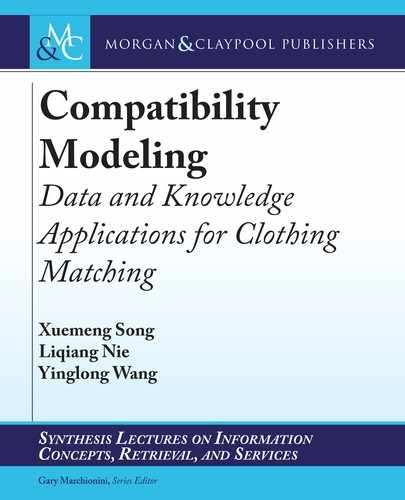
63
C H A P T E R 6
Personalized Compatibility
Modeling
6.1 INTRODUCTION
In Chapter 5, we studied how to enhance the interpretability of compatibility modeling [30] by
introducing the prototype learning. However, one important factor affecting the compatibility
assessment—the user factor, has been overlooked. As different people may hold different tastes
in clothing matching, this chapter extends the traditional general compatibility modeling to the
personalized compatibility modeling.
In a sense, most of the existing work attempts to tackle the clothing matching problem by
modeling the compatibility between fashion items from the aesthetic perspective based on the
visual and contextual contents of fashion items, but overlooks the role of user factor. Indeed, aes-
thetics can be rather subjective, as different people may have different tastes in clothing match-
ing. For example, for the same fashion item “high-neck pullover” occurred in the first outfit of
all three users in Figure 6.1, user1 coordinates it with the “point button tweed tight skirt,” while
user3 prefers to match it with the “check flare skirt with belt.” Consequently, it is inappropriate
to ignore the user context factor and access the compatibility between fashion items universally
across different individuals. To bridge this gap, this work aims to tackle the personalized cloth-
ing matching problem, where without loss of generality, we focus on the compatibility modeling
between the top and bottom while considering the user context.
However, the personalized compatibility modeling between fashion items is non-trivial
due to the following challenges: (1) although there are many public datasets toward the gen-
eral compatibility modeling and personalized fashion item recommendation tasks, respectively,
there is a lack of the large-scale benchmark dataset for personalized compatibility modeling.
Accordingly, how to construct a large-scale benchmark dataset to facilitate the evaluation of the
proposed method constitutes a tough challenge; (2) how to seamlessly encode the user prefer-
ence on clothing matching into the personalized compatibility modeling between fashion items
and thus enable the matching results not only to meet the common matching patterns but also to
cater to the user personal taste poses another challenge; and (3) fashion items can be comprehen-
sively characterized by multiple modalities, such as the visual images and contextual descriptions,
both of which may convey important cues on user preferences. For example, the visual signal can
reveal the intuitive features user prefers, like the color and shape, while the contextual modality
..................Content has been hidden....................
You can't read the all page of ebook, please click here login for view all page.
